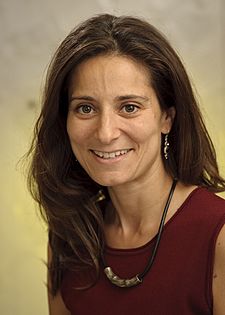Natalie Batalha facts for kids
Quick facts for kids
Natalie Batalha
|
|
|---|---|

Natalie Batalha
|
|
| Born | May 14, 1966 California, U.S.
|
| Alma mater | UC Santa Cruz (Ph.D.) University of California, Berkeley (S.B.) |
| Known for | Kepler Mission |
| Awards |
|
| Scientific career | |
| Fields | Astronomy Exoplanets |
| Institutions | UC Santa Cruz |
Natalie M. Batalha is a professor of Astronomy and Astrophysics at UC Santa Cruz. She is a leading expert in finding planets outside our solar system, called Exoplanets. Dr. Batalha was a key scientist for the Kepler Mission. This was the first space mission designed to find Earth-sized planets orbiting other stars. Before joining UC Santa Cruz, she worked at NASA Ames Research Center and San Jose State University.
Contents
About Natalie Batalha
Natalie Batalha grew up in the San Francisco Bay Area in California. She went to the University of California, Berkeley for college. She first studied business, but then switched to physics. She found it amazing that everyday things, like the rainbows you see on soap bubbles, could be explained with math.
While in college, she studied stars that are like our Sun. After getting her first degree in physics, she earned a doctorate in astrophysics from UC Santa Cruz. She also did research in Rio de Janeiro, Brazil.
Natalie Batalha's daughter, Natasha Batalha, is also an astronomer. They work together to discover and study exoplanets. They use data from the James Webb Space Telescope.
Discovering Distant Worlds
Working on the Kepler Mission
In 1997, Natalie Batalha joined the science team for the Kepler Mission. She helped design the mission and get it funded. As one of the main scientists, she helped choose the more than 150,000 stars that the telescope would watch.
She worked closely with her team at NASA to find possible planets from Kepler's data. In 2011, she led the team that confirmed the discovery of Kepler 10b. This was the first rocky planet found outside our Solar System.
Using the James Webb Space Telescope
In 2017, Natalie Batalha's project was chosen for the James Webb Space Telescope (JWST). Her project, called 'The Transiting Exoplanet Community Early Release Science Program', received the most observation time. This time was used during the first five months of the telescope's operation.
After the JWST launched in 2021, Dr. Batalha and her team made an exciting discovery. They found clear evidence of carbon dioxide in the atmosphere of an exoplanet. This planet, called WASP-39b, is about the size of Saturn. It orbits very close to a star similar to our Sun, about 700 light-years away.
In 2023, Dr. Batalha and her team used the JWST again. They found water vapor in the atmosphere of another planet, WASP-18b. They also created a temperature map of this planet.
Leading Astrobiology Research
Dr. Batalha also leads the UC Santa Cruz Astrobiology Initiative. This is a special program that brings together different types of scientists. They work together to study how life began, changed, and spread throughout the universe.
Awards and Recognition
Natalie Batalha has received many awards for her important work.
- In 2011, NASA gave her the NASA Exceptional Public Service Medal. This was for her excellent leadership of the Kepler Science Team.
- In 2017, Time Magazine named her one of the 100 Most Influential People in the World. Two other exoplanet scientists were also on this list.
- Also in 2017, she won the American Ingenuity Award in Physical Sciences from Smithsonian Magazine.
- In 2018, she received the UC Santa Cruz Alumni Achievement award.
- In 2019, she was given an honorary doctorate from the University of Uppsala in Sweden.
- She was also elected a member of the American Academy of Arts and Sciences in 2019.
- In 2020, she became a Legacy Fellow of the American Astronomical Society.
- In 2020, she was named a UC Presidential Chair for her work on the UCSC Astrobiology Initiative.

